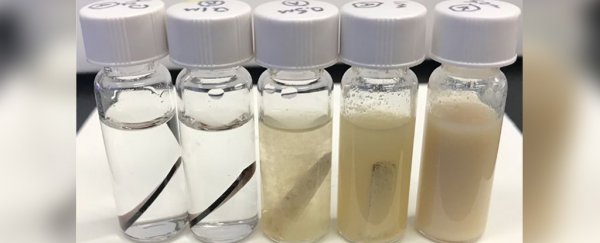In a perfect world, plastic would never be on a one-way trip into landfill - it's a vision we've strived to realise for decades. Unfortunately, some plastics just don't recycle as easily as others, limiting how well we can reuse them in new products. But a new kind of plastic might help change all that.
Researchers at the US Department of Energy's Lawrence Berkeley National Laboratory have designed a new kind of plastic polymer that can be broken down and built up again with the simplicity of a molecular Lego brick.
"Most plastics were never made to be recycled," says chemist Peter Christensen.
"But we have discovered a new way to assemble plastics that takes recycling into consideration from a molecular perspective."
All plastics are more or less repeating units – or monomers – of compounds derived from an organic substance like petroleum.
That stringy web of molecules can be mixed with a wide variety of chemicals, giving plastics diverse properties that allow us to use them for just about anything from shopping bags to clothing, to straws, and furniture.
To the eternal confusion of consumers everywhere, some of those plastics can be broken down into components and recycled relatively easily. But not all. We might be able to throw our polyethylene terephthalate (PET) drink bottles into the recycling bin, but not a tough, thermoset plastic toy or utensil.
Many plastics suffer from those additives that cling to the molecular chains to colour, soften, or harden them, making for an unpredictable mess of ingredients to convert into a durable product we can easily afford.
Researchers have made some headway on redesigning thermoset plastics to become recyclable, but to really solve our growing plastics crisis we need to make the process as efficient and simple as possible, and the new type of plastic developed at the Berkeley Lab has the potential to meet such demands.
Its building block is a monomer called diketoenamine: a compound formed by sticking a triketone to an amine.
Condensing these units into a long string forms a plastic called poly(diketoenamine) – or PDK – and the bonds can be dissolved with ease using nothing more than a 12-hour soak in a strong acid bath.
"With PDKs, the immutable bonds of conventional plastics are replaced with reversible bonds that allow the plastic to be recycled more effectively," says chemist and team leader Brett Helms.
By breaking the polymers down easily, the plastic's core units can be separated from any additives over and over again in what is described as a closed-loop cycle.
The researchers tested the recovery process by contaminating PDK and acid solutions with other substances, including fibreglass and flame-retardant chemicals, finding the additives had little impact on their diketoenamine harvest.
The end result is a plastic ingredient that can shake off any colours or strengthening agents in several easy steps to be turned back into another product.
"We're interested in the chemistry that redirects plastic lifecycles from linear to circular," said Helms.
"We see an opportunity to make a difference for where there are no recycling options."
Right now, most of our recycling efforts are abysmal. While some countries are doing all they can, countries like the US are barely managing to recycle a quarter of their PET waste.
Governments can always do their bit to enforce action, but at the end of the day, money talks. Earlier this year, researchers showed how we might be able to turn plastic into a far more lucrative resource: fuel.
Any methods we can find to make recycling easy for the consumer and appealing to the manufacturer are worth investigating.
We're of course a long way from sending our PDK forks to an acid tank at our local recycling plant. Further research is needed to test the polymer's suitability for various applications. Nobody wants a bendy plastic knife or a brittle shopping bag, no matter how recyclable it is.
But whatever the results, this is what the future of plastics looks like – and we need it urgently.
This research was published in Nature Chemistry.
